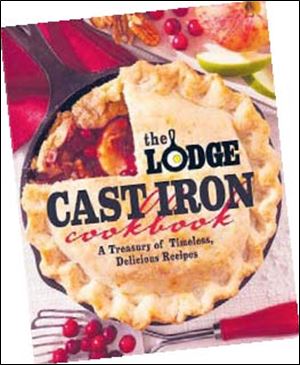
Cast-iron cookware handed down as heirlooms
3/6/2012
It might seem odd to compare an inanimate object with the living, but I can’t help but equate the role of cast-iron cookware with that of being a grandmother.
Just as a grandmother holds years of experience within her soul, cast-iron cookware holds years of seasoning within its pores.
Both are sturdy, both are dependable and, if you treat them well, they can be one of your greatest assets.
Lest you think I’m exaggerating, a peek inside The Lodge Cast Iron Cookbook will confirm the relationship.
Tucked within its pages, nestled around 200 recipes, are numerous “Cast Iron Memories” paying tribute to grandmothers whose prized cast-iron wares are still being loved by second and third-generation cooks.
Take, for instance, cookbook author Sheri Castle’s memory of her grandmother, a woman who raised 11 children.
“Each time one of her children married, she sent them off with a cast-iron skillet that she had seasoned into a gleaming ebony showpiece by using it daily until it was just right. The day after one wedding she took on the skillet intended for the next.”
And this vignette by California resident Cindy Schoeneck, whose Alabama family has cast-iron cookware that dates back five generations.
“Cast-iron cookware is a treasured possession in my family. Many pieces were passed down from one generation to the next and became ‘family heirlooms. ... Today I have one of my mother’s wedding-gift cast-iron skillets.’ “
For anyone who loves to read a cookbook, this one is hard to put down.
Turn your eyes from the written memories and you’ll find a collection of recipes to rival any cookbook or recipe box in your house. It features a Who’s Who of cooks, some formally trained, others schooled at their grandmother’s side.
Author Julia Reed, contributing editor to Garden & Gun, shares her recipe for succotash; Steven Satterfield, executive chef/owner of Miller Union in Atlanta, serves up a hearty recipe for Savannah red rice; and chef John Currence of Oxford, Miss., offers his recipe for roasted corn pudding.
Wildlife specialist J. Wayne Fears offers wild-game recipes, while a few pages are scorched with winning recipes from the Terlingua International Chili Cook-off competition held annually in Houston.
For those who love cornbread, have no worries. There’s a selection of winning recipes from the National Cornbread Festival’s Cook-off competition held yearly in South Pittsburg, Tenn. There are other cornbread offerings, as well.
And lest you need tutoring on how to care for cast-iron products, there are tips on that too.
Cornbread Supreme with Shrimp
This was the winning recipe for the 2000 National Cornbread Cook-off competition, submitted by Kay Gay and Helen Hollansworth.
3 thick bacon slices
4 large eggs
1/4 cup milk
1/2 cup (1 stick) butter, melted and cooled
1 (6-ounce) package Martha White Buttermilk or Cotton Country Cornbread Mix
6 dashes of hot pepper sauce
1 medium onion, chopped
1 (10-ounce) package frozen chopped spinach or chopped broccoli, thawed and drained well
1 pound shrimp, peeled, deveined and coarsely chopped
2 cups finely shredded sharp cheddar cheese, divided
Chopped fresh parsley for garnish
Preheat oven to 375 degrees. Cook the bacon in a 10 1/2-inch cast-iron skillet over medium-high heat until crisp. Remove to paper towels to drain. Crumble bacon and set aside.
Transfer 1 tablespoon of bacon drippings to a small bowl. Drain off the remaining drippings from the skillet and discard. Wipe skillet clean, then return the reserved drippings to the skillet. Place in the oven to heat.
Beat the eggs in a large bowl. Add the milk, melted butter, cornbread mix, and hot pepper sauce, stirring until blended. Stir in the onion, spinach, shrimp, and 1½ cups cheese. Carefully remove the skillet from the oven. Pour the batter into the hot skillet. Sprinkle the remaining 1/2 cup cheese over the top.
Bake until set and golden brown, 30-35 minutes. Remove from oven and let rest 5-10 minutes in the skillet on a wire rack. Sprinkle with bacon and parsley, if desired. Cut into wedges and serve.
Yield: 8 servings
Source: The Lodge Cast Iron Cookbook
Brother Anselm’s Popovers
Brother Anselm Clark, a classically trained baker, shares this recipe for Brother Anselm Popovers.
1 cup sifted all-purpose flour
1/4 teaspoon salt
2 large eggs
1 cup milk
1 tablespoon butter, melted
Preheat oven to 425 degrees. Grease 2 (6-cup) cast-iron muffin pans with shortening and place in the oven for 10 minutes as it preheats.
Combine the flour and salt in a medium bowl. In a small bowl, beat the eggs until foamy; add milk, stirring to combine. Gradually add the milk mixture to flour mixture, stirring just until blended. Stir in the melted butter.
Fill the wells of the prepared muffin pans 2/3 full with batter. Bake until browned, 32-35 minutes. They should have hollow centers when they come out of the oven. Turn them over and make a split in the bottom. At the table, fill the centers with gravy or jelly, depending on the meal. (Or you can simply dollop the gravy or jelly on top.)
Popovers with horseradish sauce can be prepared by adding a dash of Worcestershire sauce and a pinch of dill weed to the batter. When they come out of the oven, slit them on the bottom and fill them with the following horseradish sauce: Combine 1 cup sour cream, 2 tablespoons prepared horseradish, 1 chopped green onion, 1/4 teaspoon Texas Pete hot sauce, 1/4 teaspoon salt and 1/4 teaspoon freshly ground black pepper in a small bowl. Refrigerate sauce until ready to serve.
Yield: 12 popovers
Source: The Lodge Cast Iron Cookbook